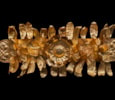Gold Wreath
The gold wreath consists of a large hammered gold strap ornamented with a central rosette, confronting leaves and repoussé scenes. The two semi-circular end sections of the gold wreath contain matching scenes showing Philoctetes’s wounded foot being treated. The story, taken from Homer’s Iliad, is best known from Sophocles’s play Philoctetes, performed at the City Dionysia in 409 BC during the Peloponnesian War. Philoctetes was a member of the Greek army that set out to besiege Troy but was bitten by a snake in the foot and the wound went putrid and stank, so the army abandoned him on the island of Lemnos. Philoktetes, however, possessed Herakles’s bow, and his aid was needed. Neoptolemus and Odysseus returned to bring the disabled Philoktetes back to Troy. The scene on each end sections depicts the hero’s wounded foot being tended to by his penitent colleagues. Gold jewellery was made with great skill and artistry in Etruria (now western Tuscany). The Etruscans were a non- Italic people whose Greek-based culture influenced the Romans from the 7th to the 5th century BC, when they were invaded by the Gauls and later overcome by the Romans. Etruscans excelled in their own styles and methods of workmanship, producing pieces of technical perfection and great variety. During the early Etruscan period they became experts in the art of goldwork, using decorative granulation, repoussé, filigree and engraving. Pieces have also been found with inlays of glass originating from Phoenicia.
Jan Mitchell, ‘The Varied Tastes of a New York Connoisseur’, Architectural Digest, November 1987, p. 298
David Aaron Ltd, 2021, No. 19.
Previously in the Private Collection of Jan Mitchell (1913–2009), NY, acquired in Geneva in 1966.
Private Collection, NY, 2009
US art market.
Private Collection, UK, acquired from the above.
ALR: S00156763, with IADAA certificate, this item has been checked against the Interpol database.
Jan Mitchell (1913–2009) was a New York based restaurateur and collector of Pre-Columbian, Meso-American, Egyptian and Classical art. Born in Sweden, he lived in Finland, Latvia and Switzerland before moving to Washington in 1950. From 1950 to 1972 he owned Luchow’s, a renowned German restaurant and beerhall in Manhattan.
He had already been a collector of ancient art before moving to the USA, buying from the dealers André Emmerich, John Weiss and Earl Stendhal. He also bought an entire collection of Pre-Colombian objects from Mrs Lisa Hoffman of Geneva.
In 1976 he loaned gold items from his Meso-American collection to the exhibition Gold of Pre-Columbian America, held in the Soviet Union, alongside items from the Rockefeller and Bache collections, and in 1985 he loaned 80 pieces to the Metropolitan Museum, New York, for the exhibition The Art of Pre-Columbian Gold: The Jan Mitchell Collection. Later, in 1991, he donated 70 objects to the Met, and in 1993 the ‘Jan Mitchell Treasury’ was opened in the museum.










 Enquire
Enquire




